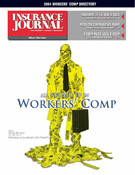If insurance brokers want to add value and differentiate themselves from their competitors in this hardening workers’ compensation marketplace, they should pay attention to the intricacies of how experience modification factors are calculated.
Experience modification worksheets are full of valuable information that can allow the broker to add value to a current client or “wow” a prospective client if they take the time to understand the experience modification formula and how the different variables involved in the formula affect the calculation.
The experience modification factor is a ratio of a company’s actual losses to losses that are to be expected in the operations of a company of like size (payroll) and employment classification (Class Code). Experience rating doesn’t apply to every business; a company qualifies for experience rating only if its base premium exceeds a minimum set by the state the company is doing business in.
An experience modification factor of 1.00 indicates an average risk. An experience modification greater than 1.00 indicates a risk with greater than expected loss experience, and an experience modification less than 1.00 indicates a risk with lower than expected loss experience.
The experience period generally consists of three years, ending one year prior to the effective date of the modifier, which is usually the effective date of the policy. For example, a policy effective April 1, 2004 would have its experience modification factor calculated by using payroll and incurred losses based on policy years 2000-2001, 2001-2002 and 2002-2003.
The 2003-2004 policy period is not used in the calculation because the loss information is too new and not yet credible enough to include in the computation. An important note is that the way the modification is calculated, losses don’t begin to factor into the equation until the second year, and will take three additional years before evolving off a company’s current experience modification factor.
Experience modification formula
The Experience Modification Formula is the calculation that is shown on the bottom of the experience modification worksheet. It is important to not be intimidated as you look at this formula but to concentrate on understanding the individual components of the formula. In looking at the formula below, you have basically six values that you need to be concerned with.
Actual primary losses: This is the first $5,000 of each loss. Actual primary losses are how the experience modification calculation takes into account claims frequency because as the insured has additional claims the actual primary losses will increase. On the experience modification worksheet the amount of actual incurred losses are in Column 9 and the actual primary losses are in Column 10.
Actual excess losses: This is for loss amounts more than $5,000 on each loss. Actual excess losses are how the experience modification calculation takes into account claims severity because as the insured has large dollar claims the actual excess losses will increase. In some cases a large loss will exceed a particular state’s per claim accident limitation and will therefore be limited in the experience modification calculation. On the experience modification worksheet the amount of actual excess losses are the difference between actual incurred losses (Column 9) and actual primary losses (Column 10). The actual excess losses can be found in Column F on the worksheet.
Expected primary losses: Actuaries at the rating bureau calculate expected loss rates (Column 2) for each classification, which are multiplied by the insured’s payroll (Column 4) to get the expected losses (Column 5) for the insured in each class code. The expected losses are multiplied by a “Discount Ratio” (Column 3), which represents the amount of expected losses that are expected primary losses. The expected primary losses on each individual claim can be found in Column 6 of the worksheet and the sum of expected primary losses can be found in Column E of the worksheet. The expected loss rates and discount ratios are published in National Council Compensation Insurance (NCCI) tables.
Expected actual losses: The difference between the sum of expected losses (Column D) and the sum of expected primary losses (Column E). The expected actual losses can be found on the experience modification worksheet in Column C.
Ballast value (Column G): This will limit the effect of any single loss on your experience modification. The ballast value increases as the expected losses increase but at a rate slower than expected losses. These values are published in the NCCI table of ballast values.
Weighting value (Column A): This value is a ratio and limits the effect of your excess losses on the experience modification factor. The weighting value increases as the expected losses for a risk increase. Therefore, the larger the risk, the more weight is placed on the actual excess loss experience. These values are published in the NCCI table of weighting values.
Also, many states have adopted the experience rating adjustment, which reduces all medical only claims by 70 percent before the numbers are utilized in the experience modification calculation. The reason behind this adjustment was to decrease the incentive for employers to pay the small medical only claims themselves and not report them to the insurance company. Insurance carriers and the NCCI feared that these claims could be handled incorrectly and unreported data could skew rates in future years. With this adjustment, indemnity claims have a greater impact than medical only claims and insured’s need to know how much a loss time claim can affect their experience modification factor.
For example, a $3,000 medical only claim will be reported as a $900 primary loss, but a $2,900 medical and a $100 indemnity claim will be reported as a $3,000 primary loss because the indemnity payment prevented the medical only classification.
Because the excess losses are multiplied by the weighting value in the Experience Modification Formula, it reduces their effect on the experience modification calculation. The primary losses are not multiplied by the weighting value and therefore have a more significant impact on the experience modification than excess losses.
Since primary losses are a measure of frequency and excess losses are a measure of severity, we now see that the frequency or number of claims has a greater impact than severity or dollars paid on the experience modification calculation. Multiple claims that total $10,000 will increase your experience modification factor more than a single loss of $10,000. The way the experience modification worksheet is set up, it is easy to do a quick review to see how the insured compares to his industry on frequency and severity. If box (I) is greater than box (E) than the insured has an above average frequency risk. If Actual Ratable Excess is greater than Expected Ratable Excess the insured has above average severity risk. This is a helpful analysis when you are meeting with a prospect and you can get a solid understanding of what is driving their losses in a quick time frame.
Proactive approach
In regards to current clients, brokers need to be proactive in managing its client’s expectations about their experience modification factor. This can be done by doing forecasting experience modification throughout the year, using up to date loss runs from the experience period. This is helpful because it gives the broker the ability to educate his client on the variables that drive the factor. In turn, brokers are able to give advice on what risk management controls should be put into place to lower the factor.
The experience modification factor is a direct cost or savings to the insured and the insured has complete control on what the modification will be.
Jeremiah Howard is a senior vice president of program development at Magellan Insurance Services, a newly-formed MGA in San Diego, Calif. He can be reached at Jhoward@magellanins.com.
Topics Agencies Profit Loss Claims Workers' Compensation Excess Surplus
Was this article valuable?
Here are more articles you may enjoy.


 Chubb Wins Latest Battle With New York Diocese in Bid to Avoid Sex Abuse Claims
Chubb Wins Latest Battle With New York Diocese in Bid to Avoid Sex Abuse Claims  Why New York’s Attorney General Objects to Trump’s Bond Insurer
Why New York’s Attorney General Objects to Trump’s Bond Insurer  Former Congressman Charged After Collision with State Trooper in Florida
Former Congressman Charged After Collision with State Trooper in Florida  Aon Completes $13B Acquisition of Middle-Market Broker NFP
Aon Completes $13B Acquisition of Middle-Market Broker NFP 


